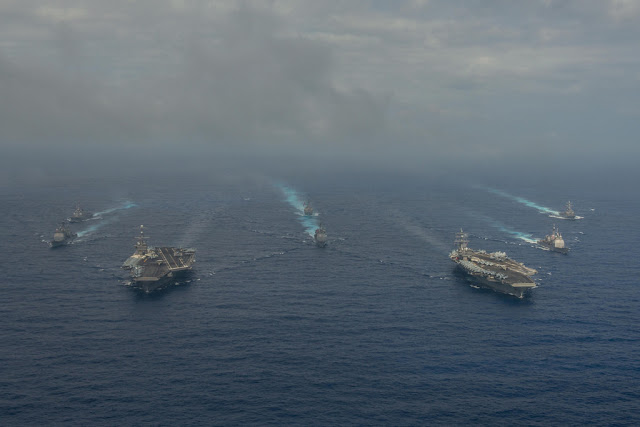

| Online: | |
| Visits: | |
| Stories: |
Things heat up near South China Sea: two U.S. aircraft carriers, B-52s and EA-18G Growler detachment!
Some interesting photographs have been arriving from the troubled waters of Indo-Asia-Pacific region.
The most recent ones, released on Jun. 18, show the USS John C. Stennis (CVN 74) and USS Ronald Reagan (CVN 76)carrier strike groups (CSG 3 and CSG 5) crusing close each other during dual carrier flight operations in the Philippine Sea.
Such operations included air combat training, long-range strike training, air defense drills as well as sea surveillance.
The CSG 3, that started operations in the Western Pacific on Feb. 4, consists of the aircraft carrier USS John C. Stennis (CVN 74), guided-missile cruiser USS Mobile Bay (CG 53) and guided-missile destroyers of Destroyer Squadron (DESRON) 21, USS Stockdale (DDG 106), USS Chung-Hoon (DDG 93) and USS William P. Lawrence (DDG 110), and the aircraft of Carrier Air Wing (CVW) 9.
CSG 5, begun its summer patrol of the Indo-Asia Pacific, on Jun. 4, and consists of the aircraft carrier USS Ronald Reagan (CVN 76), guided-missile cruisers USS Shiloh (CG 67) and USS Chancellorsville (CG 62) and guided-missile destroyers from Destroyer Squadron (DESRON) 15, USS Curtis Wilbur (DDG 54), USS McCampbell (DDG 85), USS Benfold (DDG 65); the aircraft of Carrier Air Wing (CVW) 5, is forward-deployed to Yokosuka, Japan and routinely, patrols the Western Pacific.
According to the U.S. Navy, the CSGs (Carrier Strike Groups) began coordinated operations in international waters to demonstrate “the United States unique capability to operate multiple carrier strike groups in close proximity.”
U.S. Navy aircraft carriers regularly conduct dual carrier strike group operations in the Western Pacific and sometimes also in the South China Sea, East China Sea and Philippine Sea: this occurs when carriers deployed to the 7th Fleet area of operations from the U.S. West Coast are joined with the forward deployed carrier strike group from Japan. When it happens a force of 12,000 sailors, 140 aircraft, six combatants and two carriers operates in the same sea: an impressive “show of force.”




